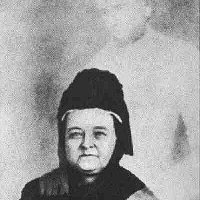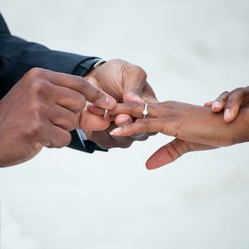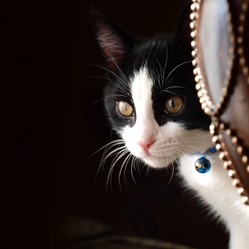Spirit photography is claimed to have been accidentally discovered by William Mumler of Boston, Massachusetts, in 1861. Mumler, it is said, focused the lens of his camera on a vacant chair with the object of taking a self-portrait. His story was that after uncapping the lens he immediately jumped into position on the chair and sat there for a few seconds. On developing the plate he found an additional image of a little girl sitting on his knee. Mumler claimed that he recognized this photograph as being that of a young relative who had died some twelve years previously. He continued his experiments and stated that the extra figures of his plates became so frequent as to be embarrassing. In this way Mumler became the first professional spirit photographer.
Early Frauds
Mumler claimed that the extra figures were actual objective photographs of spirit forms present in the studio; invisible to the naked eye but capable of being recorded by the camera. For a while, Mumler's theory was accepted until it was found that photographs of living people appeared on his plates. He was accused of fraud and died in poverty in 1884. His results show every evidence of having been produced by double exposure.
Mumler was imitated by many others (usually professional photographers) both in this country and the U.S.A. Almost without exception, these self-styled spirit photographers were convicted of fraud. In many instances they actually confessed to trickery. In 1906, the London Daily Mail appointed a committee to investigate the claims in regard to spirit photography, but for lack of the human material with which to experiment the venture produced no results.
Check more on Amazon
 | The Strange Case of William Mumler, Spirit Photographer (Fesler-Lampert Minnesota Heritage Books) In the 1860s, William Mumler photographed ghosts—or so he claimed. Faint images of the dearly departed lurked in the background with the living, like his well-known photo of the... |
 | Photography and Spirit (Reaktion Books - Exposures) Can film capture what our eyes can’t see? There are many examples—both historical and contemporary—of photographs of spirits or “ghosts.” These images alternately have been deri... |
 | The Perfect Medium: Photography and the Occult In the early days of photography, many believed and hoped that the camera would prove more efficient than the human eye in capturing the unseen. Spiritualists and animists of th... |
The Crewe Circle
It was about this time (1908) that a group of spiritualists, who went by the name of the Crewe Circle, began to attract attention. These people conducted operations from a private house at Crewe. They claimed to be non-professional and had no fixed fees, but the sitters were expected to make a financial contribution towards "expenses". This circle attracted world-wide attention and many investigators made the pilgrimage to the little house at Crewe.
In actual fact, the Crewe circle was founded upon a Mr William Hope who was undoubtedly a schizophrenic. On one side of his character was an alert, witty and patently honest Northcountryman, whilst on the other hand there was the bogus medium who used prayers and psalmsinging as a cloak for his fraudulent operations. Hope described his work as "psychic photography" and · he and his followers maintained that the results produced were not actually photographs of spirits but were spirit-produced photographs.
For the extraneous forms on these so-called psychic photographs they used the name of "extras".
By the simple method of employing several cameras simultaneously, independent investigators easily proved that there was no question of objective spirit forms since the "extra" appeared on one of the plates only-and that, the one under Hope's control.
The usual procedure was for a sitter to take along an unopened box of plates which he loaded in Hope's darkroom. He then sat for Hope to take his portrait after which they both retired to the darkroom again to develop the plates. One of these usually showed an "extra". In every observed instance where there was an "extra" on the plate Hope either handled, or could have handled, the plate before exposure.
Although many of the sitters for whom "extras" appeared were unknown to Hope, it was significant that out of over a thousand cases investigated, where the extra was a recognizable likeness of someone known to the sitter, it was an exact copy of some existing photograph or illustration.
At first Hope appears to have produced his "extras" by substituting his own doctored plates for the sitter's. After he was caught at this he elaborated new methods. One of these appears to have involved the use of luminous paint. A positive transparency backed with calcium sulphide and pressed into contact with an unexposed plate will leave an "extra" negative image in addition to anything else that may be recorded there before or after.
Psychographs
Written messages obtained by the Crewe Circle on photographic plates held between the hands and not exposed in the camera were named "psycho graphs".
These psychographs were of somewhat rare occurrence and, apart from the actual handwriting, they provided little of evidential value.
Many of them were in Hope's handwriting and contained grammatical and spelling mistakes such as he was in the habit of making.
Careful investigation proved that in no single instance had Hope produced a message in facsimile handwriting from persons with whom he had not corresponded during their lifetime.
Examination showed that he had built up his psychographs by cutting out words and phrases from these letters and filling in the blanks in his own hand. There were obvious attempts to conceal the cut edges, and Hope's own style was only too evident in the forged writing.
Hope's fraudulent methods were eventually confirmed by one of his greatest friends and supporters, and when he died in 1932 the Crewe Circle died with him.
The late Sir Arthur Conan Doyle was a keen supporter of Hope and his works. It has now been proved that he and others of his time were sadly lacking in the critical faculty desirable for analysing the claims of such people as Hope. The truth is that Sir Arthur was so thoroughly honest himself that he could not believe it possible that trickery was rampant in what, to him, was a very sacred subject.
Investigations
There have been many other variations on the above themes, but in every case impartial investigation has revealed evidence of substituted plates and double exposure.
Examination of the wrappings of the plates taken to the seance by the sitter in many cases shows signs of opening and re-sealing.
With one medium, the substituted "extra" bearing plates were found to have one roughened edge. This indicated the top of the plate so that it could be inserted in the dark slide the right way for the "extra" to appear upright with respect to the image ofthe sitter.
Plates that have previously been exposed to give an "extra" can usually be detected by examining the margins; the clean rebate almost always has a doubled edge because the plate never lies in exactly the same position in the holder for the two exposures.
Finally, the Society for Psychical Research have made it clear, in a report covering some hundreds of claims, that so far their investigators have never seen any alleged "spirit" photograph that could not have been produced by natural means.
The publication of this report may explain why spirit photography has now gone out of fashion in Great Britain. Elsewhere, however, claims still continue to be made.





 Photographic Styleon 10/14/2011
Photographic Styleon 10/14/2011
 Interchangeable Lenseson 09/28/2011
Interchangeable Lenseson 09/28/2011
 Negative Blisters and Blemisheson 09/17/2011
Negative Blisters and Blemisheson 09/17/2011
 Photographyon 08/22/2011
Photographyon 08/22/2011



Comments
It seems that more and more pictures are capturing inexplicable images. Interesting topic!
Great article! While I do believe in spirits, or ghosts, whatever you want to call them, due to my own experiences, I know there is a lot of fraud out there by people trying to make a buck off the beliefs of others...or to make a believer out of skeptics. I had no idea how these hoaxes of spirit photography were perpetrated until reading this article. Fascinating information.
I have always been fascinated by "spirit" photography. In fact, I even own a photograph which appears to show an angel in the background. While I will agree, most of these are likely a hoax, I do think there is some truth to the possibility of photographing spirits. What ever would make us think we are here alone?
This is very interesting information about spirit photography. I've thought the idea of real spirit photography was intriguing, but figured it was probably a hoax.